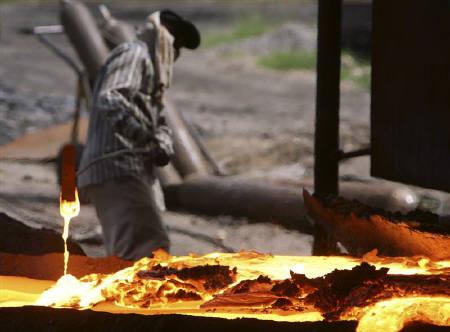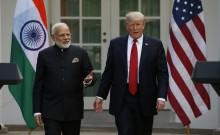
India's steel consumption is expected to grow at its fastest pace in five years next year on Prime Minister Narendra Modi's infrastructure push, but a scarcity of raw materials means it will be at the expense of another key goal -- curbing imports.
In his triumphant election campaign, Modi criticised the last government for exporting iron ore but importing steel. But his first five months as the prime minister has coincided with a surge in imports of both, denting his high-decibel drive to make India an export powerhouse.
India's steel imports from China, the world's biggest producer of the alloy, doubled in April-September from a year ago though the country has enough capacity to meet its demand.
While India's consumption is expected to rise, China will continue to see a downtrend, likely leading to a flood of cheap steel from China just as Modi pushes ahead with a signature 'Make in India' initiative to boost industry.
Charged by the strongest electoral mandate in three decades, Modi has staked his reputation on making India an export hub, launching his pet campaign with much fanfare in September with a lion as its logo.
Soaring steel imports, however, underscore the challenges Modi faces in realising his dream. Steelmakers, such as JSW, are clamouring for higher import tariffs.
"The 'Make in India' slogan has to be true for steel also," said Ravinder Bhan, deputy general manager of marketing at state-owned Steel Authority of India. "Let steel firms get iron ore and other raw materials. But that's not happening."
India, Asia's third-largest economy, has become a major importer of iron ore and coal despite having big reserves of both at home. Once a top exporter, India is now bringing in shiploads of iron ore due to court action against illegal mining that has stifled supply, while coal behemoth Coal India is struggling to boost production.
The shortages mean that India's steel industry is running at 80 percent of capacity. But the World Steel Association expects Modi's pro-business plans -- building 100 new 'smart' cities, creating new logistic hubs and residential townships -- to spur steel demand that has been weak in recent years.
CHINA IMPORTS JUMP
World Steel expects India's demand to rise 3.4 percent to 76.2 million tonnes in 2014, after growth of 1.8 percent in 2013. Structural reforms and improving confidence will support a further 6 percent growth in 2015, it said.
Indian steelmakers such as JSW, Tata Steel and Jindal Steel and Power Ltd, however, run the risk of being priced out by their Chinese competitors.
"The global market is such that the only thing that you can do is take some protective action to save the (Indian) industry," said A.S. Firoz, chief economist at a Steel Ministry unit. "Otherwise you can't decide what the global prices will be or at what price China will export steel."
A Steel Ministry spokesman said he had no immediate comment on whether authorities would consider raising tariffs, although a government official who spoke on condition of anonymity said the issue was being looked into.
China, the world's largest steel producer, rolls more steel in a month than India, the fourth largest producer, manages in nine months. But a slowdown in China means it is set to end with a surplus of about 100 million tonnes a year.
"MADE OUTSIDE INDIA"
A tonne of reinforcement steel produced in India for use in buildings can cost up to 15,000 rupees ($244) more than that from China, according to Firoz.
Shipments into India jumped 33 percent to 4.19 million tonnes in April-September from a year ago, with imports from China leaping 108 percent to 1.34 million tonnes. Total steel imports in the fiscal year to next March 31 could nearly double to 9 million tonnes, JSW predicts.
"Through 'Make in India', Modi is saying that India should be the hub for the rest of the world and of course to meet our full demand," said N.C. Mathur, president of the Indian Stainless Steel Development Association.
"Instead something made outside India is coming into the country. That's a big threat. It's a week after week, month after month survival issue."

















